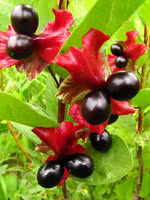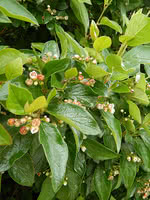Mon-Fri 9am - 5pm Mountain time
Bracted Honeysuckle vs Shiny Cotoneaster (Hedge Cotoneaster)
Lonicera involucrata
Cotoneaster lucidus
NOT AVAILABLE THIS SEASON - MIGHT RETURN
COMING SOON
(new stock expected: later this season)
Bracted Honeysuckle is a shade loving shrub that is distinguishable from other honeysuckles by its square stem and pointed leaves. Native to most of North America, this honeysuckle is found along swamps, rivers, riparian zones and moist wooded areas.
If you have a erosion control project in mind, consider Bracted Honeysuckle.
The Shiny Cotoneaster (Hedge Cotoneaster) is a dense, deciduous shrub that gets its name from the glossy dark green leaves that turn an eye-catching mix of red and purple in the fall.
It produces small, pink flowers in spring and by late summer they are followed by red berries that ripen to black. This plant is great for attracting wildlife as it is loved by both birds and butterflies.
While the Shiny Cotoneaster does produce berries, they are inedible to humans. This plant takes pruning and shearing well, making it easy to shape to your liking and is a great choice for a hedge or privacy screen in your yard.
Bracted Honeysuckle Quick Facts
Shiny Cotoneaster (Hedge Cotoneaster) Quick Facts
Toxicity: may cause stomach upset

